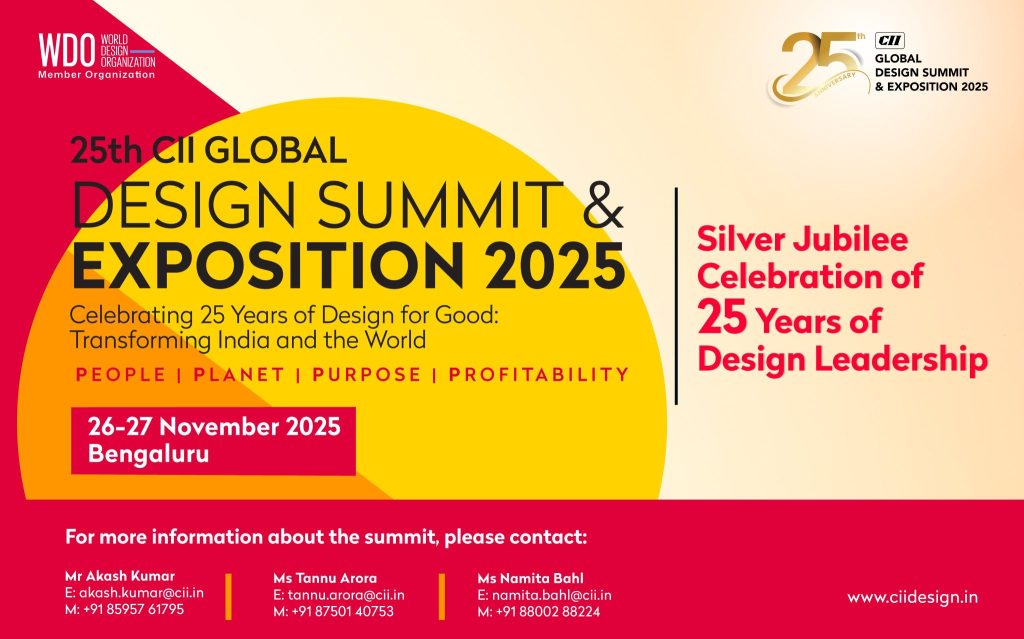The Confederation of Indian Industry (CII) has positioned design as a cornerstone of India’s competitive advantage in an increasingly complex global marketplace. For more than 125 years, CII has shaped India’s development trajectory, and today, through its National Committee on Design, it champions design as a transformative tool for economic growth, social development, and environmental sustainability.
Design as Economic Imperative
CII’s vision recognizes a fundamental economic reality: businesses can no longer compete on price and functionality alone. In a crowded global market, design has become the differentiator that drives innovation and competitive growth. Research demonstrates that enterprises integrating design into their operations experience measurable improvements in turnover, profitability, and market competitiveness. For Indian businesses facing severe price pressure, design serves as a necessary means of differentiation, particularly crucial for micro, small and medium enterprises (MSMEs) that constitute the backbone of India’s industrial base.
The organization emphasizes that design is not a cost but a value creator. Good design produces simultaneous economic, social, and environmental benefits, making it a strategic investment rather than an expenditure. Through design, companies innovate more frequently and more effectively, shifting competition away from price-based dynamics toward innovation-driven markets.
Multi-Dimensional Applications
CII recognizes design’s multi-disciplinary and integrative function that cuts across numerous areas of national concern—urban development, enterprise and trade development, education, capability building, culture, heritage, and tourism. The organization advocates for systematic and creative processes that place human needs at the core, solving problems through responsible change.
In public services, CII identifies three critical applications for design: redesigning service delivery around citizens; developing better policy through testing ideas before national-scale investment; and fostering innovation to address contemporary challenges that yesterday’s solutions cannot solve. Government procurement policies, representing significant spending across the nation, represent untapped opportunities for more innovative, sustainable, inclusive, and cost-effective solutions through design thinking.
Environmental and Urban Priorities
CII’s vision extends to environmental stewardship and urban development. Good design reduces waste, uses resources prudently, and minimizes carbon footprints. By examining product and service lifecycles, design contributes to energy efficiency, sustainable living, water conservation, and waste minimization. Rather than demanding behavioral change, design offers alternatives that encourage reduced consumption while maintaining quality of life.
On urbanization, CII recognizes cities as growth engines requiring intelligent design intervention. Rapid urbanization and deteriorating infrastructure demand design-led solutions in infrastructure planning, environmental sustainability, and place-making that fosters emotional connection to urban spaces.
Bridging the Industry-Design Divide
Despite design’s proven value, its adoption across Indian industry remains limited. CII’s National Committee on Design addresses this gap through specific objectives: promoting design as a national competitiveness tool, raising industry awareness (especially among MSMEs), enriching design practice in India, and building international design community engagement.
The committee works to bridge the industry-design divide, recognizing that many companies lack understanding of design’s strategic applications. Through advocacy, knowledge dissemination, and creating platforms for industry-designer collaboration, CII seeks to transform design from a peripheral consideration into a central strategic function.
The 25th Global Design Summit as Catalyst
This vision comes into sharp focus at the 25th CII Global Design Summit & Exposition 2025 (November 26-27, Bengaluru), marking 25 years of CII’s design leadership. The Silver Jubilee edition, themed “People, Planet, Purpose, Profitability” serves as a platform for catalyzing the organization’s strategic agenda.
The summit features seven focus tracks addressing contemporary design challenges: creative economies, AI ethics, circular design, future mobility, aerospace and defence innovation, fashion and lifestyle, and urban development. The expo showcases design excellence while the CII India Design Policy 2025 launch signals strategic direction for design-driven national development.
Forward-Looking Agenda
CII’s approach positions design as a way of thinking—a set of cognitive skills, methods, and tools that defines problems and makes solutions real. The organization’s 2024-25 theme, “Globally Competitive India: Partnerships for Sustainable and Inclusive Growth,” reflects this perspective. By embedding design across government schemes, business strategies, and public service delivery, CII envisions India leveraging design as its pathway to sustained global competitiveness while addressing social and environmental imperatives.
Contributor



